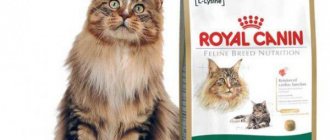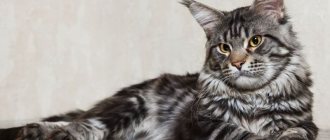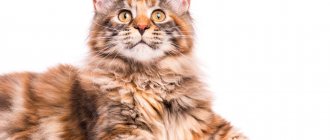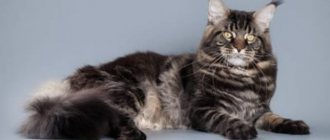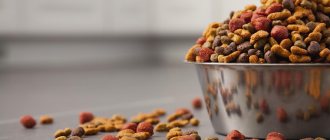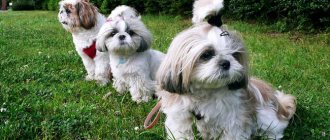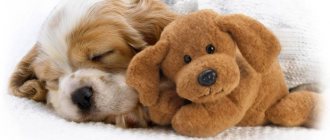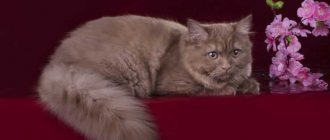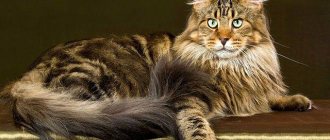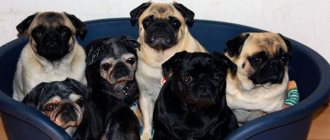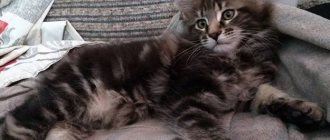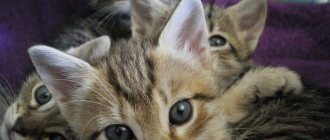Solid or solid
Maine Coons, wearing a solid coat, are rare representatives of their breed. This type of color is characterized by monotony and uniformity, excluding any manifestations of the pattern. It is quite difficult to achieve such a result - it requires long and painstaking work by geneticists.
White
When a white kitten is born, it often has gray spots on its head, which disappear as it matures. Often such individuals have heterochromia of the eyes - a beautiful and mysterious phenomenon in the form of irises of different colors, which looks especially impressive against the background of a white purring cloud.
Black
No less interesting option. At the same time, black cats can be painted in a variety of shades, such as obsidian-charcoal or warm chocolate. Heterogeneity of the coat most often appears during molting, which requires increased care during this period.
Blue
This cool, aristocratic color appealed to owners of cats of various breeds. Maine coons also liked it, which European animal lovers have already appreciated.
Red
Popularly known as the redhead. This type is somewhat problematic for bringing out uniformity. On the fur of red cats one can often observe marbled or striped elements of varying degrees of saturation.
Cream
The cream color, similar to the previous one, includes the manifestation of tabby characteristics. The main coat color is a lightened version of the previous one and comes in peach and ginger tones.
EMS color code
The International Association of Felinologists has developed a table that includes color options recognized by professional breeders. We need such a systematic collection for the convenience of making entries in the pedigree of the animal, bringing information about the breed to a single standard.
Unified table of coat colors according to EMS coding.
Thus, all colors not included in the standard coding are considered coat color defects. Individuals with unrecognized colors are not allowed at exhibitions and are not used in breeding.
However, they are suitable for home keeping in the same way as those with coat colors included in the table. Representatives of this breed have many genetically determined color options. Each Maine Coon is beautiful in its own way, no matter what color nature gave it.
Patterned or tabby
It is tabby that is the natural coloring of animals, the manifestation of patterns of which breeders are diligently trying to block. This type is characterized by the arrangement of clear stripes in the shape of the letter “M” on the forehead and around the eyes of cats. The paws, body and tail of such a pet are also decorated with a specific pattern, and the hairs themselves have a heterogeneous striped color, which is also called “agouti”.
Tabby includes several subspecies:
- classical. The peculiarity of this variety is the pattern on the sides of the animal, corresponding to the stains of marble. Typical representatives of this group are Maine Coons with a black merle color;
- spotted. In this case, the pattern on the fur consists of specks folded into dotted lines;
- brindle. Regular clear stripes located parallel to each other make the cat look like the animal of the same name;
- ticked. An alternative name is Abyssinian. This color is pure agouti without spots, stripes or patterns. Due to its physical resemblance to another breed, the ticked tabby is considered a deviation from the standards.
What are the conditions for keeping the animal?
When deciding to adopt a large pet into the family, you should take care of creating a suitable corner in the house. It is best to consult with breeders which hygiene and interior items are ideal for the needs of a black Maine Coon. The cat will feel better if the owner takes care of the following things:
| Adaptations | Recommendations |
| Bed | Selected taking into account the active growth of the animal or specialized models are purchased |
| scratching post | Must support the weight of the pet and correspond to its dimensions |
| Toys | Models must be safe and do not contain beaded or button embellishments. |
| Soft balls and mice will be a winning option | |
| Tray | It is recommended to give preference to wide ones without high sides |
| Completely closed ones are not suitable, as the animal will not fit in it. | |
| Filler | It is better to choose a brand of litter that the cat is accustomed to in the nursery. |
| A bowl | Animals are better served by bowls made of glass, ceramic or steel rather than plastic. |
Tortoiseshells
This class is characterized by the presence of red, brown, beige and black spots scattered throughout the animal’s body in a chaotic manner. As with tricolors, tortoiseshells are predominantly female. Meeting such a cat is rare luck with a probability of 1:3000. In this case, most likely, it will be sterile.
This color is variegated and includes many variations with the presence or absence of white, silver, and smoky inclusions. Depending on the nature of the location of the spots, the tortoiseshell color is typed as:
- scaly - colors alternate in a checkerboard pattern;
- chintz - black and red elements look like scraps of fabric;
- solid - the areas of fur characteristic of the group are large and clearly defined;
- patterned - various patterns are superimposed on the tortoiseshell spots.
Among the rare types of color you can also find the “dilute tortoiseshell”, which looks interesting thanks to the combination of cream and blue.
Random color combination
Sometimes there are situations when the maine has a color that does not fit any of the color types. For this purpose, its own classification was created. These colors can be called:
- Brown tabby with spots. Such an animal has spots of red and brown.
- Blue spotted tabby. The cat in this case has cream and blue stripes on its body.
- Creamy blue. The spots are scattered in a chaotic manner throughout the body. This color is sometimes called a blue turtle.
- Creamy blue, white.
- Spotted tabby with white spots. The color is similar to the previous one, but there are inclusions of white spots.
Such combinations are also rare.
Smoke or silver
This group is characterized by root discoloration of the hairline with a basic black or blue color. Depending on the ratio of white and pigmented areas, the following color varieties have been recorded:
- pigment only on the tips of the guard hairs - “chinchilla”;
- one-quarter painted – “shaded smoke”;
- 50/50 – “smoky”.
In addition, there are representatives with “black” or “blue smoke” fur, where snow-white roots occupy a smaller part of the hair. But silver cats are a little lighter than smoky ones. However, their main difference is their invariably green eyes.
Origin story
The history of the origin of all native cat breeds, including the giant Maine Coons, is shrouded in legends and myths.
The first hypothesis about how this breed appeared dates back to the times of the Vikings, when they conquered new lands. In the year 1000, warriors traveled on their boats to the New World, and with them the ancestors of Norwegian forest cats got there. However, the Vikings were soon forced to return to the old continent. But the cats stayed for a long time, and as a result of crossing with local cats, the Maine Coon appeared.
The second version dates back to the time of the French Revolution, when Queen Marie Antoinette planned her escape from Paris (1793). She sent her cats to Captain Samuel Clough's sailing ship in advance. The couple of monarchs did not manage to leave France, but the animals safely reached the shores of the United States in Maine. There the cats received new blood from local animals, which became the basis for the formation of a new breed.
Another legend says that Maine Coons are the offspring of a domesticated cat and a wild Manx raccoon.
Objective data about Maine Coons appeared only at the beginning of the twentieth century, when “The Book of the Cat” by the American Frances Simpson was published in 1903. In it, the author described in detail both her own pets and the animals that belonged to her friends. The beginning of the story dates back to 1861, which became the main starting point in the biography of this extraordinary breed. Then there are almost no blank spots left in the Maine Coon chronicle:
- Beginning in 1860, Maine farmers exhibited local cats during the annual fair.
- Most of all, Maine Coons were valued not for their external qualities, but for their incomparable ability to hunt rodents - the large cat easily coped with the invasion of mice in grain barns.
- In 1895, 12 Maine Coons took part in the first national North American show - the cat Cozy from Maine was named the winner of this show.
Then history made an unpleasant zigzag - in the twentieth century, the large Maine Coon breed was almost destroyed by the expansion of the Persians and Turkish Angora cats. In 1911, the aborigines took a prize for the last time at an exhibition in Portland and disappeared from the field of view of felinologists for 40 years.
The big cats were rescued in the same place where their lineage began - in the agricultural regions of America. Farmers were indifferent to fashion trends, but they were concerned about the safety of the crop. So the Maine Coons did what they knew how to do best - catch rodents.
In 1976, the breed was completely restored, it returned to international exhibitions and from that time on never disappeared. Another 9 years later (1985), Maine Coons were recognized as the official state cat of Maine.
This is interesting! Red Maine Coons belong to the group of “talkative” cats. They masterfully control their voice and love to purr loudly, meow in every way, and sometimes even imitate the sounds of the surrounding nature.
